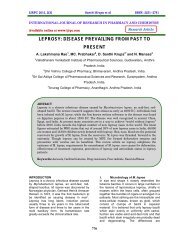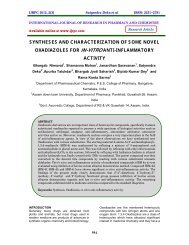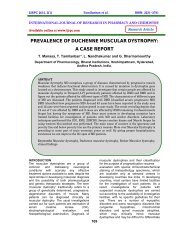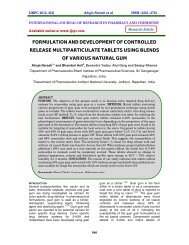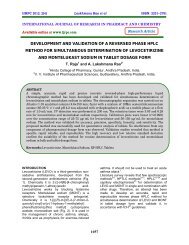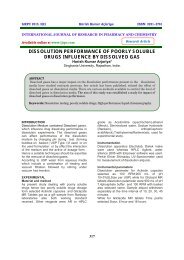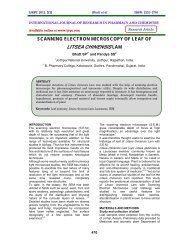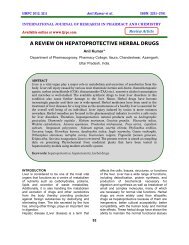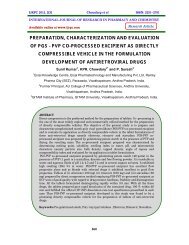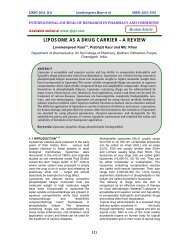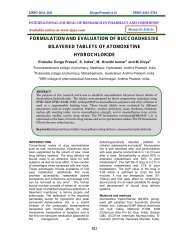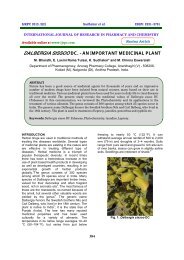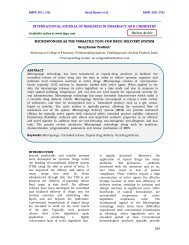synthesis and antimicrobial activity of some new 1,3,5 ... - ijrpc
synthesis and antimicrobial activity of some new 1,3,5 ... - ijrpc
synthesis and antimicrobial activity of some new 1,3,5 ... - ijrpc
You also want an ePaper? Increase the reach of your titles
YUMPU automatically turns print PDFs into web optimized ePapers that Google loves.
IJRPC 2012, 2(2) Anupama et al ISSN: 22312781<br />
INTERNATIONAL JOURNAL OF RESEARCH IN PHARMACY AND CHEMISTRY<br />
Available online at www.<strong>ijrpc</strong>.com<br />
Research Article<br />
SYNTHESIS AND ANTIMICROBIAL ACTIVITY OF SOME<br />
NEW 1,3,5-TRISUBSTITUTED-2-PYRAZOLINES<br />
B. Anupama 1* , Subas Ch<strong>and</strong>ra Dinda 2 , Y. Rajendra Prasad 3 <strong>and</strong> A. Vasudeva Rao 3<br />
1 K.V.S.R. Siddhartha College <strong>of</strong> Pharmaceutical Sciences, Vijayawada, Andhra Pradesh, India.<br />
2 School <strong>of</strong> Pharmaceutical Education <strong>and</strong> Research, Berhampur University, Berhampur, Orissa, India.<br />
3 Pharmaceutical Chemistry Division, A U College <strong>of</strong> Pharmaceutical Sciences, Andhra University,<br />
Visakhapatnam, Andhra Pradesh, India.<br />
ABSTRACT<br />
A variety <strong>of</strong> 1, 3, 5-trisubstituted-2-pyrazolines (3a-k) were synthesized by reacting various<br />
chalcones with phenyl hydrazine hydrochloride. The required chalcones were prepared by<br />
condensation <strong>of</strong> 3-acetylthiophene with various substituted aromatic / hetero-aromatic aldehydes<br />
in the presence <strong>of</strong> alkali. All these compounds were characterized by IR, 1 H NMR <strong>and</strong> elemental<br />
analyses. The <strong>new</strong>ly synthesized compounds were evaluated for their <strong>antimicrobial</strong> <strong>activity</strong> <strong>and</strong><br />
<strong>some</strong> <strong>of</strong> them have shown significant <strong>activity</strong> when compared with the st<strong>and</strong>ard.<br />
Keywords: 1,3,5-trisubstituted-2-pyrazolines, Antimicrobial <strong>activity</strong>.<br />
INTRODUCTION<br />
Considerable interest has been focused on the<br />
pyrazoline structure, which has been known to<br />
possess a broad spectrum <strong>of</strong> biological<br />
activities such as tranquilizing, muscle<br />
relaxant, psycho-analeptic, anticonvulsant,<br />
antihypertensive <strong>and</strong> antidepressant activities 1-<br />
6 . The discovery <strong>of</strong> this class <strong>of</strong> drugs provides<br />
an outst<strong>and</strong>ing case history <strong>of</strong> modern drug<br />
development <strong>and</strong> also points out the<br />
unpredictability <strong>of</strong> biological <strong>activity</strong> from<br />
structural modification <strong>of</strong> a prototype drug<br />
molecule. Prodrug-based monoamine oxidase<br />
(MAO) inhibitors having hydrazide, hydrazine<br />
<strong>and</strong> amine moiety such as isocarboxazide 7 ,<br />
phenelzine 8 , meclobemide 9,10 show prominent<br />
antidepressant <strong>activity</strong> in laboratory animals<br />
<strong>and</strong> humans. Additionally, tranylcypromine like<br />
MAO inhibitors mechanism-based inactivators<br />
<strong>and</strong> they are metabolized by MAO with one<br />
electron <strong>of</strong> the nitrogen pair to generate an<br />
imine, the other residing on a methylene<br />
carbon. The structures <strong>of</strong> synthesized<br />
compounds are very similar to that <strong>of</strong><br />
isocarboxazide. Earlier studies by Parmar et<br />
al. 3 <strong>and</strong> soni et al. 4 demonstrated monoamine<br />
oxidase inhibitory activities <strong>of</strong> <strong>some</strong> 1, 3, 5-<br />
triphenyl-2-pyrazolines, 1-thiocarbamoyl-3,5-<br />
diphenyl-2-pyrazolines <strong>and</strong> bicyclic<br />
pyrazolines in behavioural despair test. 11-14<br />
These observations prompted the authors to<br />
carryout the <strong>synthesis</strong> <strong>of</strong> <strong>some</strong> <strong>new</strong> 1, 3, 5-<br />
trisubstituted-2-pyrazolines (3a-k) which were<br />
also evaluated for their <strong>antimicrobial</strong> <strong>activity</strong>.<br />
EXPERIMENTAL<br />
Chemicals <strong>and</strong> solvents were <strong>of</strong> reagent grade<br />
<strong>and</strong> used without further purification. Melting<br />
points were determined on a capillary melting<br />
point apparatus <strong>and</strong> are uncorrected. 1 H NMR<br />
spectra were recorded in the indicated solvent<br />
on Bruker WM 400 MHz spectrometer with<br />
TMS as internal st<strong>and</strong>ard. IR spectra were<br />
recorded in KBr on Perkin-Elmer AC-1<br />
spectrophotometer. Microanalyses were<br />
performed on Carlo Erba EA-1108 element<br />
analyzer <strong>and</strong> were within the ± 0.4% <strong>of</strong> the<br />
theoretical values. Column chromatography<br />
was performed on silica gel (Merck, 60-120<br />
mesh).<br />
GENERAL PROCEDURE FOR THE<br />
PREPARATION OF PYRIMIDINES<br />
A mixture <strong>of</strong> chalcones (3a-k) <strong>of</strong> 3-<br />
acetylthiophene (1 mmole), phenylhydrazine<br />
hydrochloride (1 mmole) in absolute ethanol<br />
(20 mL) <strong>and</strong> pyridine (0.3 mL) was added drop<br />
wise at room temperature. After that the<br />
mixture was refluxed for 5-6 h <strong>and</strong> the solvent<br />
was evaporated completely. The reaction<br />
249
IJRPC 2012, 2(2) Anupama et al ISSN: 22312781<br />
mixture was poured into ice -cold water <strong>and</strong><br />
the solid mass that separated out was filtered,<br />
dried <strong>and</strong> purified by column chromatography<br />
with ethylacetate/ hexane <strong>and</strong> recrystallized<br />
from chlor<strong>of</strong>orm to give 1, 3, 5-trisubstituted-2-<br />
pyrazolines (3a-k) (Scheme 1). The chemical<br />
<strong>and</strong> spectral data <strong>of</strong> the compounds (3a-k) are<br />
given in Tables 1 <strong>and</strong> 2.<br />
S<br />
O<br />
C<br />
H H<br />
Pyridine, Ethanol<br />
C C Ar<br />
NHNH 2 .HCl<br />
N<br />
Reflux S<br />
1 2 3a-k<br />
N<br />
Ar<br />
Scheme-1<br />
Where Ar<br />
OCH 3 N(CH3 ) 2 CH 3<br />
Cl<br />
S<br />
3a 3b 3c 3d 3e 3f<br />
Cl<br />
NO 2 OCH 3<br />
NO 2<br />
Cl<br />
F<br />
OCH 3<br />
3g<br />
3h<br />
3i<br />
3j<br />
3k<br />
OCH 3<br />
Table 1: Physical characterization data <strong>of</strong> the compounds (3a-k)<br />
Compound Ar Molecular formula M.p ( o C) Yield (%)<br />
3a 2"-thienyl C 17 H 14 N 2S 2 (C,H,N) a 210 71<br />
3b 4"-methoxyphenyl C 20 H 15 N 2OS (C,H,N) a 214 68<br />
3c 4"-dimethylaminophenyl C 21 H 21 N 3S (C,H,N) a 137 74<br />
3d 4"-methylphenyl C 20 H 18 N 2S (C,H,N) a 172 68<br />
3e Phenyl C 19 H 16 N 2S (C,H,N) a 212 76<br />
3f 4"-chlorophenyl C 19 H 15 ClN 2S (C,H,N) a 239 74<br />
3g 2",4"-dichlorophenyl C 19H 14 Cl 2N 2S (C,H,N) a 246 73<br />
3h 4"-fluorophenyl C 19 H 15FN 2S (C,H,N) a 227 68<br />
3i 3"-nitrophenyl C 19 H 15 N 3 O 2S (C,H,N) a 205 71<br />
3j 4"- nitrophenyl C 19 H 15N 3 O 2S (C,H,N) a 231 72<br />
3k 3",4"5"-trimethoxyphenyl C 22 H 22 N 2 O 3S (C,H,N) a 237 71<br />
a<br />
Elemental analyses for C, H,N are within ± 0.4% <strong>of</strong> the theoretical values<br />
250
IJRPC 2012, 2(2) Anupama et al ISSN: 22312781<br />
Table 2: Spectral data <strong>of</strong> the compounds (3a-k)<br />
Compound IR (KBr, cm - 1 )<br />
1 H NMR (CDCl 3, ppm)*<br />
3a<br />
1594 (C=N), 1112 (C-N) <strong>and</strong> 706 (C-S)<br />
3.25 (1H, dd, H A), 3.80 (1H, dd, H B), 5.50 (1H, dd, H x) <strong>and</strong><br />
6.80-7.50 (11H, Ar-H)<br />
3b<br />
1642 (C=N), 1355 (C-N), 670 (C-S) <strong>and</strong> 3.13 (1H, dd, H A), 3.77 (1H, dd, H B), 5.25 (1H, dd, H x), 3.85<br />
1160 (-O-CH 3)<br />
(3H, s, -OCH 3) <strong>and</strong> 6.70-7.62 (12H, Ar-H)<br />
3c<br />
1520 (C=N), 1080 (C-N) <strong>and</strong> 690 (C-S) 3.10 (6H, s, N (CH 3) 2), 3.21 (1H, dd, H A), 3.80 (1H, dd, H B),<br />
5.50 (1H, dd, H x) <strong>and</strong> 6.70-8.10 (12H, Ar-H)<br />
3d<br />
1648 (C=N), 1352 (C-N), 660 (C-S) <strong>and</strong><br />
2.35 (3H, s, Ar-CH<br />
1160 (-O-CH 3), 3.15 (1H, dd, H A), 3.83 (1H, dd, H B),<br />
3)<br />
5.28 (1H, dd, H x) <strong>and</strong> 6.80-7.50 (12H, Ar-H)<br />
3e<br />
3f<br />
3g<br />
3h<br />
3i<br />
3j<br />
3k<br />
1525 (C=N), 1078 (C-N), 698 (C-S) <strong>and</strong><br />
1160 (-O-CH 3)<br />
3.16 (1H, dd, H A), 3.88 (1H, dd, H B), 5.29 (1H, dd, H x) <strong>and</strong><br />
6.75-7.50 (13H, Ar-H)<br />
1595 (C=N), 1097(C-N), 689 (C-S) <strong>and</strong> 3.18 (1H, dd, H A), 3.85 (1H, dd, H B), 5.30 (1H, dd, H x) <strong>and</strong><br />
822(C-Cl)<br />
6.40-7.90 (12H, Ar-H)<br />
1645 (C=N), 1082 (C-N), 855 (C-Cl) <strong>and</strong> 3.05 (1H, dd, H A), 3.91(1H, dd, H B), 5.6 (1H, dd, H x) <strong>and</strong><br />
716 (C-S)<br />
6.70-7.60 (11H, Ar-H)<br />
1640 (C=N), 1080 (C-N), 870 (C-F) <strong>and</strong> 680 3.18 (1H, dd, H A), 3.88 (1H, dd, H B), 5.28 (1H, dd, H x) <strong>and</strong><br />
(C-S)<br />
6.80-7.45 (12H, Ar-H)<br />
1648 (C=N), 1080 (C-N), 1510 (N=O, 3.15 (1H, dd, H A), 3.86 (1H, dd, H B), 5.35 (1H, dd, Hx) <strong>and</strong><br />
asymmetric), 1335 (N=O, symmetric) <strong>and</strong><br />
6.45-7.80 (12H, Ar-H)<br />
660 (C-S)<br />
1594 (C=N), 1542 (N=O, asymmetric), 1336 3.15 (1H, dd, H A), 3.85 (1H, dd, H B), 5.25 (1H, dd, Hx) <strong>and</strong><br />
(N=O, symmetric), 1105(C-N) <strong>and</strong> 693 (C-<br />
6.50-7.60 (12H, Ar-H)<br />
S)<br />
1640 (C=N), 1068 (C-N), 655 (C-S) <strong>and</strong> 3.5 (1H, dd, H A), 3.78 (1H, dd, H B), 5.20 (1H, dd, Hx) <strong>and</strong><br />
1180 (-O-CH 3)<br />
6.45-7.60 (10H, Ar-H)<br />
* s, singlet; dd, double doublet; d, doublet; m, multiplet<br />
ANTIMICROBIAL ACTIVITY<br />
Cup plate method 15,16 using Mueller – Hinton<br />
agar medium was employed to study the<br />
preliminary antibacterial <strong>activity</strong> <strong>of</strong> (3a-k)<br />
against B. subtilis, B. pumilis, E. coli <strong>and</strong> P.<br />
vulgaris. The agar medium was purchased<br />
from Hi media Laboratories Ltd., Mumbai,<br />
India. Preparation <strong>of</strong> nutrient broth, subculture,<br />
base layer medium, agar medium <strong>and</strong> peptone<br />
waster was done as per the st<strong>and</strong>ard<br />
procedure. Each test compound (5 mg) was<br />
dissolved in 5 mL <strong>of</strong> dimethyl sulfoxide (1000<br />
µg/mL). Volumes <strong>of</strong> 0.05 mL <strong>and</strong> 0.1 mL <strong>of</strong><br />
each compound were used for testing.<br />
Same cup plate method using PDA medium<br />
was employed to study the preliminary<br />
antifungal <strong>activity</strong> <strong>of</strong> (3a-k) against A. niger<br />
<strong>and</strong> P. crysogenium. The PDA medium was<br />
purchased from Hi media Laboratories Ltd.,<br />
Mumbai, India. Preparation <strong>of</strong> nutrient broth,<br />
subculture, base layer medium <strong>and</strong> PDA<br />
medium was done as per the st<strong>and</strong>ard<br />
procedure. Each test compound (5 mg) was<br />
dissolved in 5 mL <strong>of</strong> dimethyl sulfoxide (1000<br />
µg/mL). Volumes <strong>of</strong> 0.05 mL (50 µg) <strong>and</strong> 0.1<br />
mL (100 µg) <strong>of</strong> each compound were used for<br />
testing. The cups each <strong>of</strong> 9 mm diameter were<br />
made by scooping out the medium with a<br />
sterilized cork borer in a petri dish, which was<br />
streaked with the organisms. The solutions <strong>of</strong><br />
each test compound (0.05 mL <strong>and</strong> 0.1 mL)<br />
were added separately in the cups <strong>and</strong> petri<br />
dishes were subsequently incubated.<br />
Sparfloxacin <strong>and</strong> Fluconazole were used as<br />
st<strong>and</strong>ard (reference) drugs <strong>and</strong> dimethyl<br />
sulfoxide as a control which did not reveal any<br />
inhibition. Zone <strong>of</strong> inhibition produced by each<br />
compound was measured in mm <strong>and</strong> the<br />
results are presented in Tables 3 <strong>and</strong> 4.<br />
251
IJRPC 2012, 2(2) Anupama et al ISSN: 22312781<br />
Table 3: Antibacterial Activity <strong>of</strong> Pyrimidine Derivatives (3a-k)<br />
Compound<br />
Zone <strong>of</strong> inhibition (in mm)<br />
B.subtilis B.pumilis E.coli P.vulgaris<br />
3a<br />
A 8 9 7 9<br />
B 12 12 10 13<br />
3b<br />
A 10 9 8 9<br />
B 12 14 11 13<br />
3c<br />
A 11 12 11 13<br />
B 13 14 9 11<br />
3d<br />
A 10 9 8 9<br />
B 14 13 11 13<br />
3e<br />
A 11 10 9 9<br />
B 15 14 12 14<br />
3f<br />
A 13 10 13 10<br />
B 17 15 16 16<br />
3g<br />
A 14 12 12 11<br />
B 20 18 15 17<br />
3h<br />
A 15 14 14 12<br />
B 21 18 18 18<br />
3i<br />
A 10 9 8 9<br />
B 14 13 11 13<br />
3j<br />
A 12 11 13 11<br />
B 18 17 16 16<br />
3k<br />
A 11 12 10 13<br />
B 13 13 9 11<br />
C - - - -<br />
S A 22 26 19 24<br />
(0.1<br />
mL)<br />
B 25 28 24 26<br />
A: 0.05 mL (50µg); B: 0.1 mL (100µg);<br />
C: Control (DMSO); S: St<strong>and</strong>ard (Sparfloxacin)<br />
Table 4: Antifungal Activity <strong>of</strong><br />
Pyrimidine Derivatives (3a-k)<br />
Compound Zone <strong>of</strong> inhibition (in mm)<br />
A.niger P.crysogenium<br />
3a<br />
A 8 8<br />
B 11 12<br />
3b<br />
A 9 9<br />
B 13 14<br />
3c<br />
A 11 13<br />
B 14 12<br />
3d<br />
A 11 8<br />
B 13 12<br />
3e<br />
A 10 10<br />
B 14 14<br />
3f<br />
A 8 9<br />
B 14 14<br />
3g<br />
A 11 10<br />
B 14 14<br />
3h<br />
A 9 8<br />
B 14 14<br />
3i<br />
A 9 9<br />
B 13 13<br />
3j<br />
A 8 10<br />
B 14 14<br />
3k<br />
A 12 13<br />
B 13 11<br />
C - -<br />
S (0.1 mL)<br />
A 23 24<br />
B 28 27<br />
A: 0.05 mL (50µg); B: 0.1 mL (100µg);<br />
C: Control (DMSO); S: St<strong>and</strong>ard (Fluconazole)<br />
252
IJRPC 2012, 2(2) Anupama et al ISSN: 22312781<br />
RESULTS AND DISCUSSION<br />
Among the compounds tested for antibacterial<br />
<strong>activity</strong>, compounds 3h <strong>and</strong> 3g showed the<br />
highest inhibition zones, but not comparable to<br />
that <strong>of</strong> the st<strong>and</strong>ard drug at the dose levels<br />
tested. 3f, 3j also showed zones <strong>of</strong> inhibition,<br />
but less than those obtained for 3h <strong>and</strong> 3g.<br />
From the results it is evident that a fluorine<br />
substituent present at para position on the<br />
phenyl ring (3h) enhanced the antibacterial<br />
<strong>activity</strong> <strong>and</strong> this was also observed in our<br />
study in case <strong>of</strong> substituted pyrimidines having<br />
this group. Hence pyrazolines with a phenyl<br />
group having number <strong>of</strong> fluorine substituents<br />
can be synthesized as such compounds likely<br />
to possess significant <strong>activity</strong>. Similarly<br />
compounds having fluorine substituent on the<br />
thiophene ring can also be synthesized <strong>and</strong><br />
tested for its antibacterial <strong>activity</strong>. The study<br />
also reveals pyrazolines having the phenyl<br />
group substituted with other halogens can also<br />
be synthesized to have potent compounds.<br />
Among the compounds tested for antifungal<br />
<strong>activity</strong>, 3h exhibited the highest <strong>activity</strong><br />
followed by 3g <strong>and</strong> 3f. In general, many <strong>of</strong><br />
these compounds have not showed much<br />
antifungal <strong>activity</strong> when compared to<br />
fluconazole used as the st<strong>and</strong>ard. From the<br />
results it is evident that the compounds having<br />
halogens like chlorine (3f) <strong>and</strong> fluorine (3h)<br />
found to be more potent <strong>and</strong> hence<br />
compounds having number <strong>of</strong> these<br />
substituents on different positions <strong>of</strong> the<br />
phenyl ring can be synthesized in order to<br />
improve the <strong>activity</strong> further. Since, no studies<br />
in the present case were carried out with<br />
bromine as a substituent, such compounds<br />
having bromine at one or more positions <strong>of</strong> the<br />
phenyl ring can be synthesized to enhance the<br />
antifungal <strong>activity</strong>. Introduction <strong>of</strong> nitro group<br />
also contributed favorably to the antifungal<br />
<strong>activity</strong> (3i) <strong>and</strong> hence compounds with more<br />
nitro groups at different positions <strong>of</strong> the phenyl<br />
ring, if synthesized, may exhibit significant<br />
antifungal <strong>activity</strong>. Attempts can also be made<br />
to have the above substituents on the<br />
thiophene ring also in order to have a<br />
cumulative positive effect on the antifungal<br />
<strong>activity</strong> <strong>of</strong> the pyrazolines.<br />
3. Parmar SS, P<strong>and</strong>ey BR, Dwivedi C,<br />
<strong>and</strong> Harbinson RD. J Pharm<br />
Sci.1974;63:1152.<br />
4. Soni N, P<strong>and</strong>e K, Kalsi R, Gupta<br />
TK, Parmar SS <strong>and</strong> Barthwal JP. Res<br />
Commun Chem Pathol<br />
Pharm.1987;56:129.<br />
5. Yuran- Zitouni G. Chevallet P, Kilic FS<br />
<strong>and</strong> Erol K. Eur J Med Chem.<br />
2000;35:635.<br />
6. Erhan P, Mutlu A, Tayfun U <strong>and</strong> Dilek<br />
E. J Med Chem. 2001;36:539.<br />
7. Shader RI <strong>and</strong> Greenblatt DJJ. Clin<br />
Psychopharm.1999;19:105.<br />
8. Urichuk LJ, Allison K, Holt A,<br />
Greenshaw AJ <strong>and</strong> Baker GB.J Affec<br />
Discord.2000;58:135.<br />
9. Fitton A, Faulds D <strong>and</strong> Goa<br />
K.Drugs.1992;43:561.<br />
10. Ferigolo M, Barros HM, Marquardt AR<br />
<strong>and</strong> Tanhauser M.Pharmacol Biochem<br />
Behav.1998;60:431.<br />
11. Bilgin AA, Palaska E, Sunal R <strong>and</strong><br />
Arzneim Forsch. Drug Res.<br />
1992;42:1271.<br />
12. Bilgin AA, Palaska E, Sunal R <strong>and</strong><br />
Arzneim Forsch. Drug Res.<br />
1993;43:1041.<br />
13. Bilgin AA, Palaska E, Sunal R <strong>and</strong><br />
Arzneim Forsch. Drug Res.<br />
1994;49:67.<br />
14. Palaska E, Erol D <strong>and</strong> Demirdamar<br />
R.Eur J Med Chem.1996;31:43<br />
15. Banty AL. The Antimicrobial<br />
Susceptibility Test; Principle <strong>and</strong><br />
Practice, edited by Illus Lea <strong>and</strong><br />
Febiger, (Philadelphia, USA),<br />
1976:180.<br />
16. Seely HW <strong>and</strong> Van Dermark PJ.<br />
Microbes in Action: A laboratory<br />
manual <strong>of</strong> Microbiology,<br />
D.B.Taraporewala Sons <strong>and</strong> Co.,<br />
Bombay, 1975:55-80.<br />
REFERENCES<br />
1. Polevoi lG, Nauchn TR <strong>and</strong> Konf Aspir<br />
Ordin. 1-yi(peruyi) Mosk Med Inst<br />
Moscow. 1964;159; Chem<br />
Abstr.1996;65:19147d.<br />
2. Batulin YU, farmakol M <strong>and</strong> Toksikal.<br />
1968;3:533; Batulin YU.M Chem<br />
Abstr.1969;70:2236a.<br />
253



